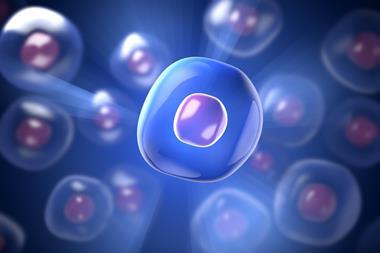
When life began, the cellular machinery for copying DNA had not yet evolved. So, as the theory goes, the first information-carrying molecules must have been self-replicators. Making self-replicators in the lab has proved difficult, although scientists have had some success using RNA molecules that are also enzymes capable of catalysing their own replication. The new study, however, led by Jack Szostak at Massachusetts General Hospital in Boston, US, focuses on another type of system – one that works without enzymes.
Szostak’s team used phosphoramidate DNA, in which oxygen atoms in the phosphodiester bonds of DNA’s sugar-phosphate backbone are replaced by nitrogen. In previous work, they made phosphoramidate DNA copies from DNA or RNA templates, but they now show they can take a phosphoramidate DNA template and make a phosphoramidate DNA copy, mimicking ‘true’ self-replication and paving the way for self-reproducing synthetic cells. ‘This phosphoramidate system is actually rather nice, because it’s compatible with the kind of vesicles we use,’ says Szostak. ‘So if we could just improve the replication process a little bit more, we might be able to use it as the genome of protocell.’
Although the system only replicates a sequence of four bases, it makes use of a chemical modification to address what Philipp Holliger of the MRC Laboratory of Molecular Biology, UK, calls a ‘big stumbling block’ for self-replicating systems: copying accuracy. Copying depends on matching adenine–thymine (A-T) and guanine-cytosine (G-C) base pairs, so mismatches such as G–T lead to errors in the transmission of the genetic code. But Szostak’s tweak – replacing T with thio-T – increases A-T stability and, crucially, the copying accuracy.
It’s not clear why thio-T makes A-T more stable, but the fact that it does raises further questions about the evolution of the genetic code. ‘You have to give an answer as to why these [modifications] were dropped,’ says Vitor Pinheiro, a synthetic biologist at the Institute of Structural and Molecular Biology, UK. Ignoring that difficult question for now, the tighter pairing also helps to increase the rate of copying – another stumbling block along the way to Szostak’s synthetic cells.
There are, though, plenty more problems left to solve. Szostak himself listed a whole host of problems for his enzyme-free self-replicators in a recent review. ‘They’re taking them down one by one,’ says Holliger. ‘Hopefully at the end of it, you’ll be able to put all this together into a system that could truly perform self-replication. And that would obviously be a spectacular thing.’







No comments yet